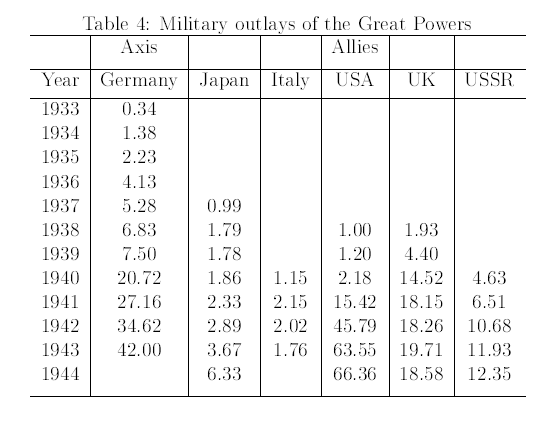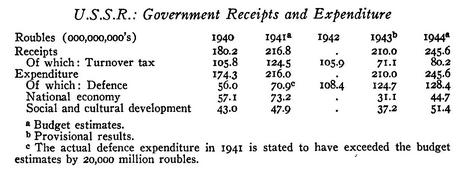Is realistic to think that German military expenditures were 2/3 of American expenditures in 1943? Well, here are the nominal German military expenditures in billion RM:
1940: 53
1941: 71
1942: 91
1943: 112
And here are the nominal American expenditures, billions of current dollars:
1941: 13.8
1942: 49.4
1943: 79.7
1944: 87.4
Some munitions prices:
Germany
Navy:
Ship ------------ cost ------ displacement -------- cost per ton
Bismarck ------ 197 MRm - 41,700 metric tons - 4,724 rm
Tirpitz --------- 181 MRm - 42,900 metric tons - 4,220 rm
Scharnhorst --- 146 MRm - 32,600 metric tons - 4,480 rm
Gneisenau ----- 143 MRm - 32,600 metric tons - 4,386 rm
Hipper ---------- 86 MRm - 16,200 metric tons -- 5,308 rm
Blucher --------- 87 MRm - 16,200 metric tons --- 5,370 rm
Prince Elgen --- 105 MRm - 17,000 metric tons -- 6,176 rm
Type VII* -------- 2 MRm --- 769 metric tons ------ 2,601 rm
From
http://forum.axishistory.com/viewtopic. ... 16#p631716)
and
http://forum.axishistory.com/viewtopic. ... 77#p628277)
*april 1943 price
Air force:
------------- aircraft ----- cost ------------ weight ---- cost per ton
1942/43 -- Ju 88 A-4 --- 254,496 rm --- 8,550 kg -- 29,766 rm
Source:
http://www.econ.yale.edu/growth_pdf/cdp905.pdf, average of the cost of the highest and lowest unit cost for the 1942/1943 fiscal year
Army:
Tank ------------ cost ------- weight-------- cost per ton
Tiger I ------- 299,800 rm -- 56.9 ---------- 5,269 rm
Panther D ---- 129,600 rm --- 43.0 -------- 3,014 rm
Panzer IV --- 115,962 rm --- 25.0 ---------- 4,638 rm
Panzer III --- 103,163 rm --- 23.0 ---------- 4,485 rm
StuG III ----- 82,500 rm ---- 23.9 ---------- 3,452 rm
Source:
http://www.panzerworld.net/prices
Note: added the cost of the gun when the price wasn't included, to be comparable to American tank prices
United States
Navy:
Ship -------------- cost ------ displacement -------- cost per ton
North Carolina -- 60 MUS$ -- 37,200 tons -------- 1,613 US$
Iowa ------------- 100 MUS$ -- 45,000 tons ------- 2,222 US$
Submarine ------ 3 MUS$ ----- 1,550 tons -------- 1,935 US$
Air force:
------------- aircraft ----- cost ------------ weight ----- cost per ton
1943 ------- B-25 -------- 151,894 -------- 8,855 kg --- 17,153 US$
1943 ------- B-26 -------- 212,932 -------- 11,000 kg -- 19,357 US$
From:
http://www.usaaf.net/digest/t82.htm
Army:
Tank ------------ cost ------- weight-------- cost per ton
M36 ------------- 51,290 ---- 29.0 ---------- 1,769 US$
M10A1 ---------- 43,677 ---- 29.6 ---------- 1,476 US$
M3A3 ----------- 54,533 ----- 14.7 ---------- 3,710 US$
M4A1(76) ------ 51,509 ----- 30.3 ---------- 1,700 US$
Computing the PPP's:
Battleships (RM/dollar): 2.32
Medium bombers (1943 prices): 1.63
Tanks: 1.93
Geometric average: 1.94
Dividing the German nominal expenditures by 1.94 we get:
1940: 27.32
1941: 36.60 (265% of US's)
1942: 46.91 (94.9% of the US's)
1943: 57.73 (72.4% of the US's)
Compare with my revised estimates of military expenditures:

It has:
1941: German outlays 176% of the US's
1942: German outlays 75.6% of the US's
1943: German outlays 66.1% of the US's
However, note that I include the Lend-Lease expenditures of the US in these revised figures (which increase US expenditures by ca. 10 billion per year).
"In tactics, as in strategy, superiority in numbers is the most common element of victory." - Carl von Clausewitz


